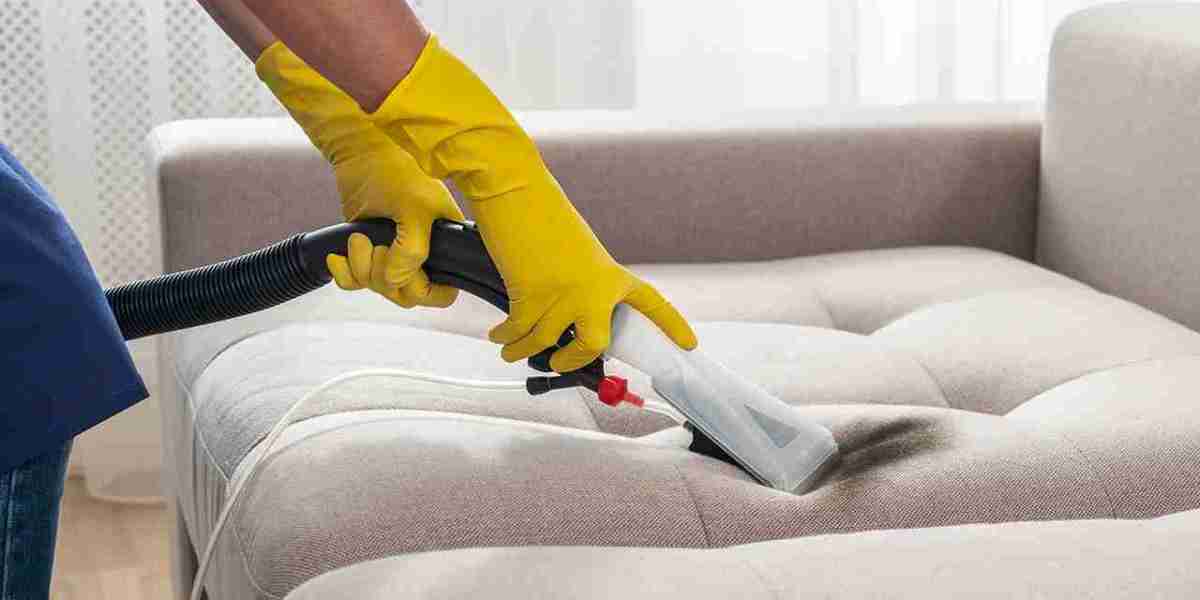A well-maintained sofa can be the centerpiece of your living room, offering comfort and style while creating a welcoming atmosphere. However, over time, sofas accumulate dust, stains, and odors, especially if they're frequently used or exposed to pets, children, or spills. Regular cleaning is key to maintaining the aesthetic appeal and longevity of your upholstery. But how can you ensure your sofa remains as fresh and vibrant as the day you bought it? In this article, we’ll delve into expert upholstery cleaning hacks that can help you revitalize your sofa without the need for expensive professional services.
Understanding the Basics of Upholstery Cleaning
Before jumping into the cleaning process, it's essential to understand the different types of upholstery fabrics. Each fabric reacts differently to cleaning methods, and using the wrong approach can cause irreparable damage. The most common upholstery materials include:
- Cotton: Soft, breathable, and durable, but prone to wrinkles and stains. It's often used in casual furniture.
- Leather: Luxurious and durable, leather requires special care to maintain its shine and texture.
- Velvet: Elegant and plush, velvet can be challenging to clean but responds well to gentle care.
- Microfiber: Resistant to stains and easy to clean, microfiber is a popular choice for families and pet owners.
- Linen: Light and airy, linen is prone to wrinkling and staining but offers a natural look to your sofa.
Understanding the fabric of your sofa is critical because the wrong cleaning agent or method can cause color fading, fabric shrinkage, or even permanent damage. Always check the manufacturer's cleaning instructions or test a small, inconspicuous area before proceeding.
1. Regular Vacuuming: The Foundation of Upholstery Cleaning
Regular vacuuming is the first step in keeping your sofa looking clean and fresh. Dust, dirt, pet hair, and crumbs accumulate quickly, and if not removed, they can grind into the fabric, causing wear and tear over time. Use an upholstery attachment on your vacuum to gently remove debris from your sofa’s surface. Be sure to vacuum both the cushions and the crevices where dirt often hides. Pay attention to seams, under the cushions, and along the backrest.
2. Spot Cleaning Stains with Household Ingredients
Spills and stains are a part of life, especially in households with children or pets. The key to dealing with stains is acting quickly. Here are a few expert hacks to tackle common stains using common household ingredients:
a. Water-Based Stains (e.g., juice, coffee, or soda)
For water-based stains, mix a small amount of mild dish soap with warm water. Dampen a cloth with the solution, then blot (don't rub) the stain. Rubbing can push the stain deeper into the fabric, making it harder to remove. Once the stain starts to lift, blot with a clean, damp cloth to rinse the soap residue. Finally, let the area air dry completely.
b. Oil-Based Stains (e.g., grease or makeup)
Oil-based stains can be trickier, but they can still be handled with ease. Sprinkle baking soda or cornstarch directly on the stain. Allow it to sit for 10 to 15 minutes to absorb the oil. Afterward, vacuum the area to remove the powder. If the stain persists, use a mixture of dish soap and vinegar (1:1 ratio) and blot gently.
c. Pet Stains and Odors
Pet owners know that sofas are prone to pet stains and odors. To clean up pet accidents, blot the affected area with paper towels or a clean cloth. Then, create a solution of one cup of vinegar, one cup of water, and a tablespoon of baking soda. Spray this mixture onto the stain, letting it sit for 10 minutes before blotting with a clean cloth. To neutralize odors, sprinkle baking soda over the entire couch, let it sit for 15-20 minutes, and vacuum it off.
3. Dealing with Odors: Refreshing Your Sofa Naturally
While stains are visible, odors can linger even if your upholstery cleaning. To refresh your sofa and eliminate odors, here are a few natural solutions:
Baking Soda: Sprinkle a generous amount of baking soda over the entire surface of your sofa, focusing on areas where odors are most noticeable. Leave the baking soda to sit for at least 15 minutes before vacuuming it up. This will absorb odors and leave your sofa smelling fresh.
Essential Oils: After using baking soda, add a few drops of your favorite essential oil (lavender, eucalyptus, or lemon) to a cloth or cotton ball and tuck it under the cushions. Essential oils can impart a pleasant scent to your sofa without overwhelming the space with artificial fragrances.
Vinegar Spray: A solution of equal parts vinegar and water can be used as an odor eliminator. Spray lightly over your sofa and let it dry. The vinegar smell dissipates as it dries, leaving your sofa smelling clean and fresh.
4. Deep Cleaning with Steam
Steam cleaning is one of the most effective ways to remove embedded dirt, allergens, and germs from your upholstery. Not only does steam clean deep into the fabric, but it also sanitizes and refreshes the fibers, making your sofa feel brand new.
If you don’t have a commercial steam cleaner, you can rent one from a local hardware store or hire a professional. If you do have a steam cleaner, follow these steps:
- Vacuum the sofa thoroughly to remove loose dirt and debris.
- Prepare the steam cleaner by filling it with water (and, if recommended, a mild upholstery cleaner solution).
- Steam the upholstery in small sections, keeping the nozzle about 6-8 inches from the fabric to avoid saturating the material.
- Allow the fabric to dry completely before sitting on it. If necessary, use a fan or open the windows to speed up the drying process.
Steam cleaning not only lifts dirt but can also help remove stubborn stains, especially on delicate fabrics like velvet or linen.
5. Leather Upholstery Care
Leather sofas exude sophistication, but they require special care to retain their luxurious appearance. Here are a few expert cleaning tips for leather upholstery:
Dust Regularly: Use a microfiber cloth to dust off the surface of the leather. This prevents dirt buildup and helps maintain the sheen of the leather.
Clean with Mild Soap: Mix a small amount of mild dish soap with water to create a gentle cleaning solution. Use a soft cloth to wipe down the leather, then dry the surface immediately with a clean, dry cloth to avoid moisture absorption.
Condition the Leather: Leather tends to dry out and crack over time. After cleaning, apply a leather conditioner to keep the material supple and prevent it from cracking. Condition your leather sofa at least once every 3-6 months.
Avoid Direct Sunlight and Heat: Leather can fade and crack when exposed to direct sunlight or heat sources. Place your leather sofa away from windows and radiators to maintain its appearance.
6. Microfiber Upholstery: The Easy-Clean Option
Microfiber is one of the most low-maintenance fabrics, but that doesn’t mean it doesn’t require care. Here are some tips to keep your microfiber sofa in top shape:
Vacuum Regularly: Like other fabrics, microfiber can trap dirt and dust. Use a vacuum with an upholstery attachment to remove debris from your sofa’s surface.
Tackle Stains Quickly: Microfiber can stain easily, but a quick response can prevent permanent marks. For water-based stains, blot the area with a damp cloth and let it air dry. For oil-based stains, use rubbing alcohol. Apply the alcohol with a cloth and gently scrub the area.
Revive the Fabric: Over time, microfiber upholstery can lose its soft texture. To restore the nap, use a soft-bristled brush to gently fluff the fibers.
7. Preventative Maintenance: Keeping Your Sofa Clean Longer
Prevention is always better than cure, and this applies to upholstery cleaning too. Here are some tips to keep your sofa cleaner for longer:
Use Slipcovers: A slipcover is an easy way to protect your upholstery from stains, pet hair, and general wear. Choose a machine-washable slipcover for easy maintenance.
Rotate Cushions Regularly: To ensure even wear, rotate your cushions regularly. This will help prevent certain areas from becoming worn out faster than others.
Avoid Eating and Drinking on the Sofa: This might be an obvious tip, but avoiding food and drink near your sofa will significantly reduce the chances of spills and stains.
Conclusion
Your sofa is an essential part of your home, and with the right care, it can continue to look great and provide comfort for years to come. By using these expert upholstery cleaning hacks, you can maintain your sofa's appearance, tackle stains, and eliminate odors without the need for professional services. Regular maintenance, gentle cleaning, and quick stain treatment are the keys to reviving your sofa and ensuring that it remains an inviting, fresh centerpiece in your living room.








